Nós and a gente: brief study of phonics overhang in popular varieties of brazilian portuguese and european portuguese
DOI:
https://doi.org/10.22481/el.v16i2.4889Keywords:
“Nós”, “a gente”; phonics overhang; Portuguese languageAbstract
It is not new that the pronouns "nós" and "a gente" are widely used in varieties of Brazilian Portuguese (BP) and European Portuguese (EP), however there are differences in the use of these pronouns that can help to differentiate one and another grammar. We analyzed BP and EP corpora and the phonics overhang variable was shown to be relevant to present these differences, considering that its P4 form was attested only in the EP corpus sample. Such an outcome might add and corroborate the hypothesis of distinct grammars that underlie the facts attested in BP and EP.
KEYWORDS: “Nós”, “a gente”; phonics overhang; Portuguese language.
Downloads
References
CHOMSKY, N. O Programa Minimalista. Massachusetts Institute of Thecnology – Cambridge, Massachusetts, USA, 1995.
CORDIAL-SIN. Corpus Dialectal para o Estudo da Sintaxe (A. M. Martins, coord.). disponível em < http://www.clul.ulisboa.pt/en/11-resources/313-cordial-sin-corpus-normalized-transcription].
KROCH , A. Mudança sintática. University of Pennsylvania, 2003.
LOPES, C. R. A inserção de a gente no quadro pronominal do português: percurso histórico. 1999. 181f. Tese de Doutorado – UFRJ, Rio de Janeiro, 1999.
LOPES, C. R. A inserção de ´a gente´ no quadro pronominal do português. Frankfurt/Madri: Vervuert/Iberoamericana, 2003, vol. 18.
NARO, A. J.; SCHERRE, M. M. P. Sobre o efeito do princípio da saliência na concordância verbal na fala moderna, na escrita antiga e na escrita moderna. In: MOURA, D. (Org.). Os múltiplos usos da língua. Maceió: EDUFAL, 1999, p. 26-37.
OMENA, N. P. de. A referência à primeira pessoa do discurso no plural. In: SILVA, G. M. de O.; SCHERRE, M. M. P. (Org.) Padrões Sociolingüísticos: análise de fenômenos variáveis do português falado na cidade do Rio de Janeiro. Rio de Janeiro: Tempo Brasileiro: Departamento de Lingüística e Filologia, UFRJ, 1986. p. 185- 215.
RODRIGUES, A. C. S. A concordância verbal no português popular em São Paulo. 1987. 259f. Tese (Doutorado em Língua Portuguesa) – Universidade de São Paulo, São Paulo, 1987.
RUBIO, C. F. Padrões de concordância verbal e de alternância pronominal no português brasileiro e europeu: estudo sociolinguístico comparativo. 2012. 392 f. Tese de doutorado – Universidade Estadual Paulista “Júlio de Mesquita Filho”, São José do Rio Preto, 2012.
SÓRIA, M. V. P. Nós, a gente e o sujeito nulo de primeira pessoa do plural. 2013. 128f. Dissertação (Mestrado em Linguística) – Universidade de Lisboa, Lisboa, 2013.
Downloads
Published
How to Cite
Issue
Section
License

Estudos da Língua(gem) is licensed under a Creative Commons Attribution 4.0 International License.
Authors who publish in the journal Estudos da Língua (gem) agree with the following terms:
The journal Estudos de Língua(gem) maintains the copyrights of the contributions published. These rights include the publication of the contribution and make its content available for free through the portal.













